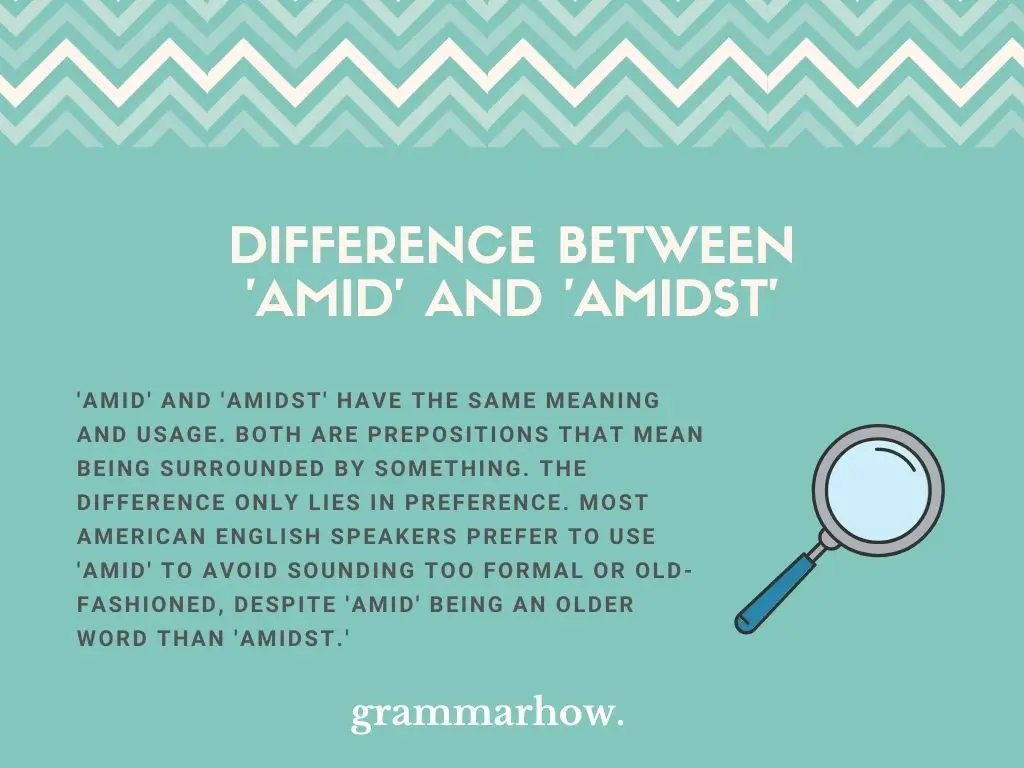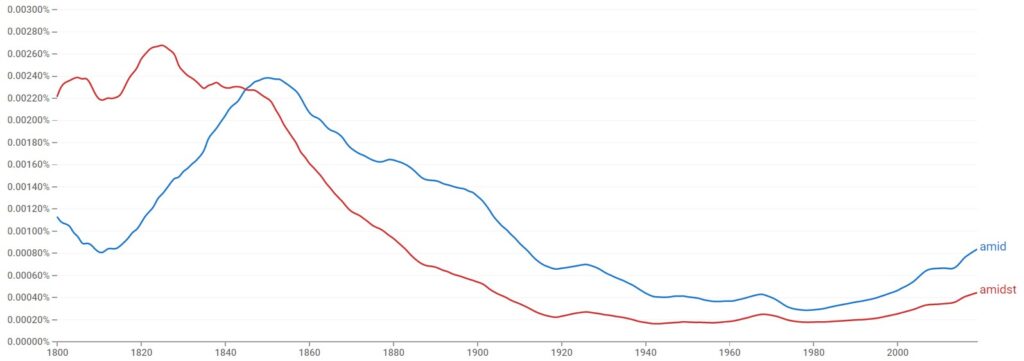In the English language, a letter or two can change the meaning of a word entirely. However, it’s also possible that two letters don’t change anything! Either way, words that have little difference can be confusing. Like ‘amid’ and ‘amidst,’ what’s the difference, and which one is more appropriate?
What Is The Difference Between ‘Amid’ And ‘Amidst’?
‘Amid’ and ‘Amidst’ have the same meaning and usage. Both are prepositions that mean being surrounded by something. The difference only lies in preference. Most American English speakers prefer to use ‘amid’ to avoid sounding too formal or old-fashioned, despite ‘amid’ being an older word than ‘amidst.’

The use of ‘amid’ was recorded even before 1000. It came from the Old English word ‘ammidan,’ which became ‘on middan,’ which means ‘in the middle.’ ‘On middan’ then became ‘amidde’ then ‘amid.’
The use of ‘amidst’ was recorded around 1250-1300. It was developed in Middle English, adding -s to ‘amidde’ and became ‘amiddes’ and then ‘amidst.’
From the history of the two words, we can see that the two essentially mean the same, which is being ‘in the middle.’ Using either ‘amid’ or amidst’ mostly rely on one’s preference or which one a speaker thinks sounds better.
According to some dictionaries, we also consider ‘amid’ as American English, while ‘amidst’ is for British English or UK English.
When Should I Use ‘Amid?’
‘Amid’ is a preposition that describes being in the middle of something or being surrounded by something. Most American English speakers prefer to use ‘amid’ to avoid sounding unusually formal or old-fashioned. In the same way, we can use ‘amid’ for more casual conversations, though also acceptable in academic English.
According to the Cambridge Dictionary, ‘amid’ is a preposition that means ‘in the middle of or surrounded by.’
Below are examples of how we use ‘amid’ in a sentence.
- Amid the obstacles along the way, they successfully wrapped up the event they organized.
- We stayed in a small camp out of town, amid tall trees and lush forests.
- Amid the chaos, the people still want to achieve peace and serenity for the nation.
- The freshman felt timid amid all the seniors that were in the event.
- The politician pleaded not guilty amid allegations and evidence of plunder and graft.
- Some of the confetti fell amid the audience at the front row.
- Amid warm applause of welcome, the guest performer walked her way to the stage.
- Anna’s missing necklace was amid her pile of clothes.
- Amid the challenges, the author published his book with success.
- Freida lived amid a beautiful lake.
When Should I Use ‘Amidst?’
‘Amidst’ is a preposition that describes being in the middle of something or being surrounded by something. For English speakers, using ‘amidst’ sounds more formal or old-fashioned than ‘amid.’ In the same way, we regard ‘amidst’ as UK English, acceptable both in the non-formal and academic context.
According to the Cambridge Dictionary, ‘amidst’ is a preposition that means ‘in the middle of or surrounded by.’ It is also considered the UK English form of ‘amid.’
Below are examples of how we use ‘amidst’ in a sentence.
- Amidst the obstacles along the way, they successfully launched the project they’ve been planning for weeks.
- We stayed in a small out-of-town transient home amidst tall trees and lush forests.
- Amidst the chaos, youth leaders still want to achieve justice and peace for the country.
- The young student felt timid amidst all the working adults in the event.
- The governor pleaded not guilty amidst allegations of different crimes like corruption.
- Some of the actor’s props fell amidst the audience in the front row.
- Amidst loud cheers of welcome, the speaker for today’s event made her way to the stage.
- Brant’s missing sock was amidst his pile of clothes.
- Amidst the challenges, the singer-songwriter was able to release her new song.
- Dana lived amidst a beautiful forest.
Is ‘Amidst’ More Formal Than ‘Amid?’
By usage and definition, ‘amidst’ is not more formal than ‘amid.’ Both are of the same degree of formality, and we can use them either for casual conversations or academic writing. Most speakers also see ‘amidst’ as more formal, so they prefer to use ‘amid’ to be more natural.
However, do not mistake preference for the degree of formality. While many prefer ‘amid’ over ‘amidst,’ both are still acceptable, and both are formal at the same level. So, in writing or conversation, feel free to use either ‘amid’ or ‘amidst.’
Are ‘Amid’ And ‘Amidst’ Interchangeable?
‘Amid’ and ‘amidst’ are interchangeable. You can use either of the two in any context because both have the same meaning. It is up to one’s preference as to which one sounds better or reads better given the sentence. Given this, ‘amid’ and ‘amidst’ can be used interchangeably.
Do mind that one may seek to achieve consistency. Consistency means that if you have applied a particular style of writing to a part of your essay, you need to use that style to the entirety of your writeup. For ‘amid’ and ‘amidst,’ we can regard ‘amid’ as American English, while ‘amidst’ is UK English. So, if you were writing in American English, use ‘amid.’ While if you were writing in UK English, use ‘amidst.’
Is ‘Amid’ Or ‘Amidst’ Used The Most?
According to the Google Ngram Viewer, ‘amid’ is used the most. It is probably because many English speakers see ‘amid’ as more natural and casual. “Amidst,’ on the other hand, has more of a too formal, old-fashioned tone to it. That said, many prefer to use ‘amid’ over ‘amidst.

Does ‘Amidst’ And ‘Amongst’ Mean The Same?
‘Amidst’ and ‘amongst’ can mean the same, but they are not interchangeable all the time. ‘Amongst’ can also mean being in the middle of something, but it can also mean being included as part of a group. For the latter purpose, we cannot interchange ‘amidst’ and ‘amongst.’
Look at the examples below.
- She lived amongst large trees and lush forests.
- She lived amidst large trees and forests.
Here, both ‘amid’ and ‘amongst’ mean that ‘she’ lived in a place surrounded by trees.
- His offensive joke caused anger among his women classmates.
- His offensive joke caused anger amidst his women classmates.
Here, ‘among’ meant that his joke caused anger to his women classmates as part of the group of ‘women.’ In this context, we cannot interchange ‘amongst’ with ‘amidst.’

Martin holds a Master’s degree in Finance and International Business. He has six years of experience in professional communication with clients, executives, and colleagues. Furthermore, he has teaching experience from Aarhus University. Martin has been featured as an expert in communication and teaching on Forbes and Shopify. Read more about Martin here.
